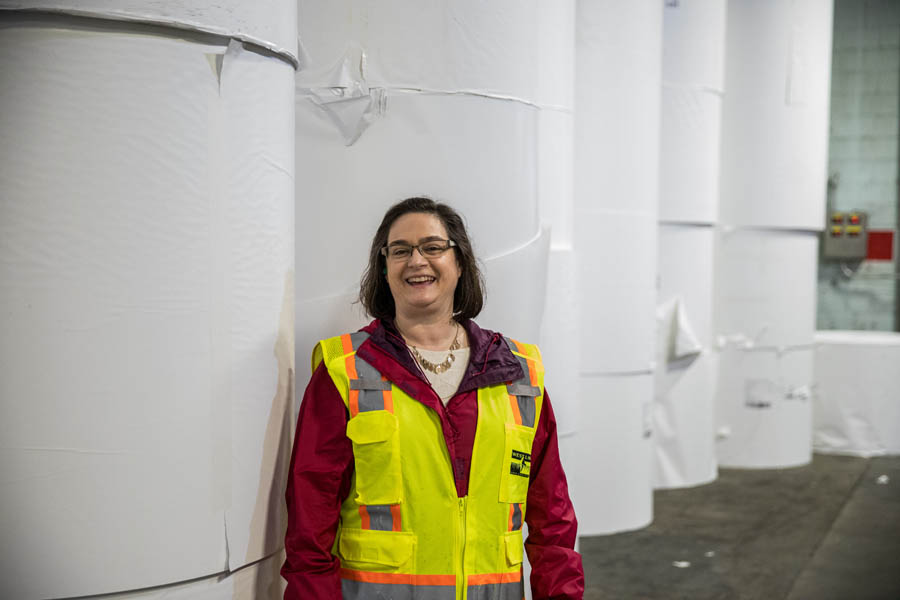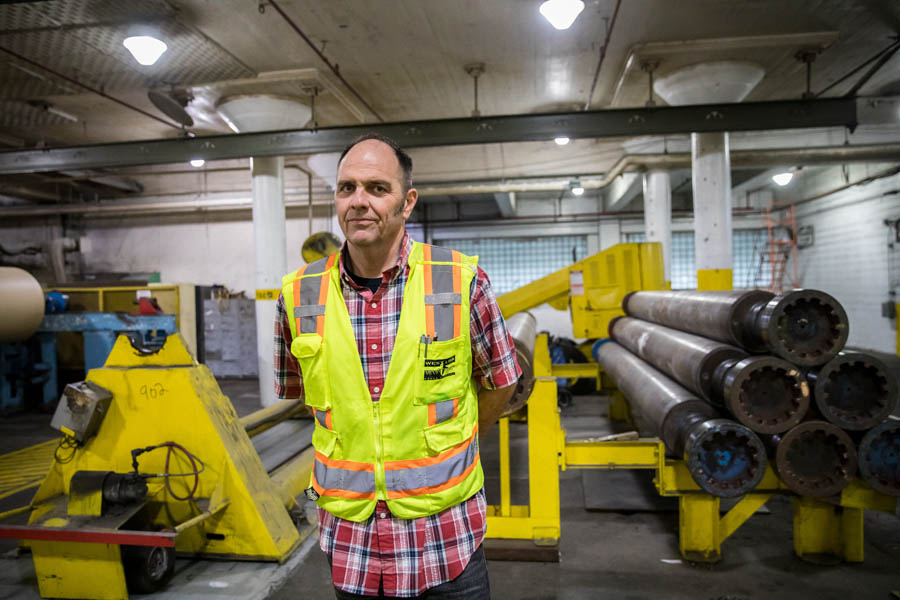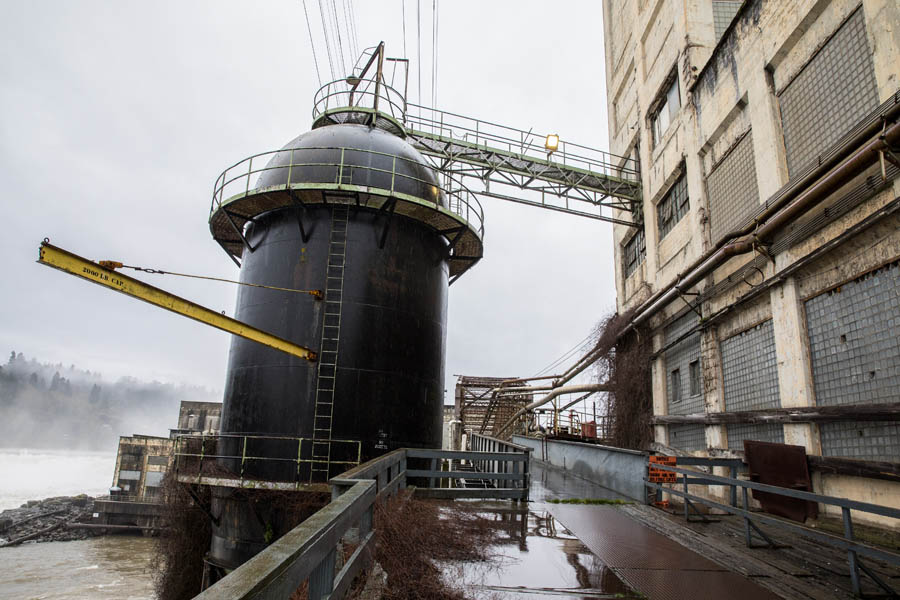A paper manufacturer finds second life with sustainable wheat pulp.
When Barb Ness arrived at West Linn Paper Company, the mill was full of people looking to score some good deals on equipment. Potential buyers who had traveled from all over the country were rushing around, taking pictures, making phone calls and comparing notes.
The auction would start any minute, a historic paper mill being sold off part by part.
Then suddenly, two of the auction organizers were riding a golf cart through the premises, alerting the crowd: “Auction’s off. Someone bought the place!”
People were not pleased.
“Oh, they were mad,” recalls Ness. But Ness was thrilled. She did not know the details yet, but if the auction was off and the mill was reopening, maybe she could land a job.
Ness was unemployed at the time. Having spent two decades in the paper industry, she thought she would check out the equipment for friends in the business. But a canceled auction could mean even better opportunities.
West Linn Paper Company was the largest and oldest employer in West Linn, a city located 20 miles south of Portland in Clackamas County. It had operated for 128 years when it abruptly shut its doors in October of 2017.
A pulp supplier’s boiler had exploded, setting off a shortage of pulp and spiking costs in the market. They ran out of pulp on a Saturday and shut the machines down that same day. Nearly 250 people lost their jobs.
Two years after shutting down, and just two months after Ness arrived for the would-be auction, the mill reopened under a new name: Willamette Falls Paper Company. More than 100 of those former employees are now back to work at positions that had so abruptly disappeared.
 Barb Ness, sales manager at the Willamette Falls Paper Company. Ness spent two decades in the paper industry before joining the reopened mill. Photo: Jason E. Kaplan
Barb Ness, sales manager at the Willamette Falls Paper Company. Ness spent two decades in the paper industry before joining the reopened mill. Photo: Jason E. Kaplan
Ness is one of a handful of newcomers. The whirring of the machines and the warmth of steam in the air have returned. But it is far from business as usual at the historic paper mill on the Willamette River.
Today, Willamette Falls Paper Company is the first paper mill in the country to produce paper using wheat pulp, a leftover material from wheat harvesting, which is typically burned in the fields, and a more sustainable alternative to traditional tree pulp.
The wheat pulp comes from Columbia Pulp in Washington. Three decades of research went into the development of North America’s first tree-free market pulp mill, and it just started producing wheat pulp for paper products in September 2019.
Ken Peterson, CEO of venture capital firm Columbia Ventures and a board member at Columbia Pulp, purchased Willamette Falls Paper Company in the final hour. Peterson has made a name for himself discovering unique, sustainable opportunities in ailing industries.
So when Brian Konen, former chief operating officer of West Linn Paper, approached Peterson about buying West Linn and incorporating the wheat pulp from his other venture, Peterson was intrigued.
 Brian Konen, CEO of Willamette Falls Paper Company. Photo: Jason E. Kaplan
Brian Konen, CEO of Willamette Falls Paper Company. Photo: Jason E. Kaplan
The deal was sealed in the nick of time on the day of the auction. Columbia Ventures bought West Linn with big plans for a product that could revolutionize the paper industry.
I met Ness, now a regional sales manager, at the entrance to Willamette Falls Paper Company on a cold, gray afternoon in January.
“You’ve got to see the falls from here. It’s the best view,” she tells me, referring to Willamette Falls, whose powerful cascade roars on the other side of this sprawling facility of concrete and steel.
But we retreat inside, away from the rain, so Ness can tell me about the paper that saved the mill.
Willamette Falls Paper Company announced the release of its new reHARVEST line in early December of last year. According to the product description, the fiber from wheat pulp “has a lower carbon footprint and uses less water and energy than conventional pulping processes.”
It is being offered in envelope, offset and coated paper grades. The reHARVEST natural kraft and bag paper is the newest addition, using the highest percentage of wheat pulp so far.
It was the new owner’s tenacity — and a responsive team — that pushed this new product to market so quickly.
Phil Harding, director of technology and sustainability, tells me the first trial run of paper incorporating wheat pulp was a career highlight for him. It was also a little rushed, from the sound of it.
Peterson had sat down with Harding and Konen (now president of Willamette Falls Paper Company) and asked them what the obstacles were to testing the first run of wheat-pulp paper. He wanted to see this happen ASAP.
But the mill had just reopened, and there were all kinds of operational obstacles that could have prevented them from trying something so new so soon. Columbia Pulp was not even producing pulp for the market at that point.
But Peterson countered each of their perceived obstacles. “Don’t we have some pulp out back?” he pressed, referring to trial pulp that had been sitting outside in the rain for weeks.
“So Brian and I are out there at 4 in the morning, hand-sorting all this old, moldy wheat pulp,” Harding recalls. They ran their first test paper after sorting through all that. “[Afterward] we were like, ‘Wow, that went really well.’”
The test run worked, and trials and research have continued ever since as the team tests different percentages of wheat pulp versus tree pulp; it is a mixture of the two, and they hope to get the wheat pulp up to 50% for certain products.
I never thought I would be captivated by paper talk. But Harding, Konen and Ness are all so excited about the prospects for this new kind of paper — it is contagious. I wonder if the mill workers’ reaction to a sustainability-focused paper line is equally optimistic. I ask Ness if there was any skepticism from returning employees.
“You know,” she says, “[the mill closing] was like a near-death experience, it seems. When everyone came back, they were like, ‘We’re ready to go. Whatever we’ve got to do.’”
Harding says it is an interesting cultural transition for a paper mill.
 Phil Harding, director of technology and sustainability at Willamette Falls Paper Company. Using wheat pulp in paper production was a “career highlight” for him. Photo: Jason E. Kaplan
Phil Harding, director of technology and sustainability at Willamette Falls Paper Company. Using wheat pulp in paper production was a “career highlight” for him. Photo: Jason E. Kaplan
“The paper industry is a historically conservative one,” he says. “And I’m an activist, a proponent of carbon taxing. I drive an electric vehicle. I wondered, am I going to fit in at a paper mill?’”
He tells me he was relieved to learn the new owner drives an electric vehicle too. Then he starts counting the number of employees who also drive electric vehicles. He gets up to four.
“And just the fact that people came back — it’s really a family here,” adds Ness. “People had retired. They found new jobs. And then they came back for this.”
Ness and Harding agree that everyone was game for the challenge of producing reHARVEST. And their enthusiasm has already been validated. The first commercial order came through just before Christmas, an eight-page spread in Real Leaders magazine, which printed in January.
The section profiles businesses “that are growing by doing good,” and the contrast between the traditional glossy pages of the magazine and the eight pages of reHARVEST — which are a smooth matte with tiny, visible flecks of fiber — serves to highlight the new product.
Todd Oakes first started working at West Linn Paper Company in 1997. He was here until it closed in 2017, and now he has returned as a paper machine operator.
“I’m such a paper nerd,” he says, sitting in a tiny metal box of a control room as two of the machines run loudly just beyond the cramped quarters.
He has just finished a 12-hour shift. “The history of paper at the falls is so cool to be a part of. Now I get to be part of building a new legacy. We’re taking something that was garbage, and we’re turning it into something viable.”
Oakes clearly shares in the passion for the new focus on sustainability. But the people here are what really motivated his return.
“You’re going to see a fat man cry,” he warns me, before sharing an example of the type of bond that brought him back.
Oakes’ wife is a two-time cancer survivor. When they received some bad news from the doctor, his co-worker asked how bad it was.
“It’s bad enough that there are some bucket-list items we’re not going to put off any longer,” Oakes told him. They were planning a 19-day cruise down the Panama Canal.
“And then he said to me, ‘You know, Todd, I rarely get around to using my vacation days,’” Oakes has to stop himself here, holding back tears. “‘So if you need any more PTO, I’ll donate mine.’”
After regaining his composure, he tells me: “These are people who really look out for each other. It’s neat to be back in that environment.”
Everyone seems optimistic about the mill’s outlook. But it is the buyers who need to be convinced. As a sales manager, it has been Ness’ job to convince both publishers and printers this new wheat pulp will not damage their machines or cause any issues.
“That’s the part I’m trying to get my climate-activist friends to understand,” says Harding, regarding big changes for sustainability in long-established industries, such as paper.
“You’ve got people who are trying to make a living, send their kids to college, pay for health insurance. That’s what ‘sustainability’ means to them. Let’s say they agree to try this new thing, and it creates delays, someone loses their job. That’s the fear. You’ve got to respect that.”
Ness has been traveling to printers to ease those fears in person — to be there and explain all the details as the new paper passes through their printing machines.
“But it runs beautifully — no problem,” says Harding. “It’s also cost competitive.”
The reHARVEST line has been on the market since December and makes up about 5% of Willamette Falls Paper Company’s business. The momentum behind reHARVEST is fueling bigger goals, too.
Harding tells me the company hopes to make a completely wood-free paper eventually. Konen wants to put in a recycling plant on-site. They are also looking at using hemp fiber. But these things take time.
 Willamette Falls Paper Company’s pulp storage vessel, which is no longer in use. It is from the days when the mill still had an attached pulp mill. Photo: Jason E. Kaplan
Willamette Falls Paper Company’s pulp storage vessel, which is no longer in use. It is from the days when the mill still had an attached pulp mill. Photo: Jason E. Kaplan
For now, more than 100 people have jobs producing a product that reduces the waste and the carbon emissions of wheat harvesting and paper production, while also reducing the need to cut down trees.
And the partnership between Columbia Pulp and Willamette Falls Paper Company is proving that wheat farmers’ agricultural waste is a viable new revenue stream.
It was a series of risks that are paying off for people and the planet.
“Again and again,” says Harding, “everything that we would do in the best interest of our employees fits hand in glove with sustainability.”






